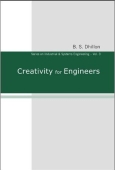 Book reviews
Book reviews-
Creativity for Engineers
Detailed review of:
Creativity for Engineers
Publishers
: World Scientific, Singapore
Authors
: Balbir Singh Dhillon, Professor, University of Ottawa, Canada
Title
: Creativity for Engineers
Year of Publication
: 2006
Pages
: 181
ISBN
: 9812565299
Reviewer
: Krishna B. Misra
Status
:
Review published in IJPE, Vol. 2, No. 4, October 2006, p. 382.
There are eleven chapters in this book arranged in the following sequence:
Introduction (11 pages)
Engineering: An Introduction (13 pages)
Famous Engineering Inventions, Inventors, and Inventing (14 pages)
Creativity in Organizations (11 pages)
Creativity Management and Manpower Creativity (14 pages)
Creativity Methods (19 pages)
Creativity Measurement and Analysis (19 pages)
Creativity Climate (13 pages)
Creativity Barriers (13 pages)
Creativity in Quality Management, Software Development Process, Rail Transit Stations, and Specific Organizations (12 pages)
Creativity Testing, Recording and Patents (10 pages)
Plus:
Appendix: Bibliography: Literature on Creativity (20 pages)
Index (5 pages)
There are not many books available on the subject of creativity, specifically for engineers and this excellent
and compact book comes from an author who has written several books with many reputed publishers in the area of engineering management, design, reliability, safety and quality. The present book comes out as a result of his teaching the subject of system design and creativity at the University of Ottawa. The book assumes no prerequisite for engineers for understanding the material presented and claims to provide all necessary information that otherwise could only be obtained by browsing several published articles, reports or books on general creativity. Also provided is a long list of bibliography (20 pages) at the end of the book if someone wants to have more information on the subject.
Section 1.5 of the first chapter provides the definitions and explanation of terms used in the context of creativity, which in the opinion of reviewer should have proceeded even before history and need for creativity. This chapter also indicates where to look for information on creativity. Also the reviewer feels that first and second chapter should have been swapped and second and third chapters should have been combined in to one chapter wherein all the material concerning what is implied by engineering, its scope and important engineering inventions and the responsibilities of an engineer should have been discussed. It can be argued that one can write a complete book on this aspect but the reviewer feels that the author has done justice to the subject by meticulously abridging the information that can be put in a chapter like this. The author has done good by defining terms like science and engineering but the reviewer feels that technology should also have found a place in setting right many notions that bother the audience to whom this book is addressed.
Chapter 4 should have gone along with the necessity for creativity in an organization and in fact emphasizes the importance of placing high priority for creativity if the organization has to survive in this competitive world of business. This chapter also provides basic steps for inculcating creativity in an organization. Chapter 6, which discusses at length the methods of nurturing creativity in an organization, is the core of creativity techniques. This chapter in the opinion of the reviewer should have followed chapter 4.
In fact the management aspect should have come after creativity measurement and analysis has been discussed. In fact the same is true for chapter 10 and chapter 11. Chapter 10 which at length identifies the organizations that have resorted to creativity cultivation in their organizations with benefit, particularly in quality management, software development, rail transit stations etc. Chapter 9 discusses the kind of barriers the organization may come across in the implementation of creativity methods and thereby providing a complete coverage of the subject. The authors has not missed to suggest the use of many reliability techniques like fault tree analysis, cause and effect diagram, probability tree analysis etc, that can be fruitfully used in the context of creativity.
In the opinion of the reviewer, the author has done more than what an author of a book on such a subject could have done particularly when there are not many books available on the subject and this book being the first attempted effort to write one in a structured manner. The reviewer would like to recommend this book to all the engineers and engineering organizations who would like to take advantage of improving their business through the development of products, system and services that have an edge over others through creative designs.
Krishna B. Misra
Review published in the International Journal of Performability Engineering, Vol. 2, No. 4, October 2006, p. 382.


